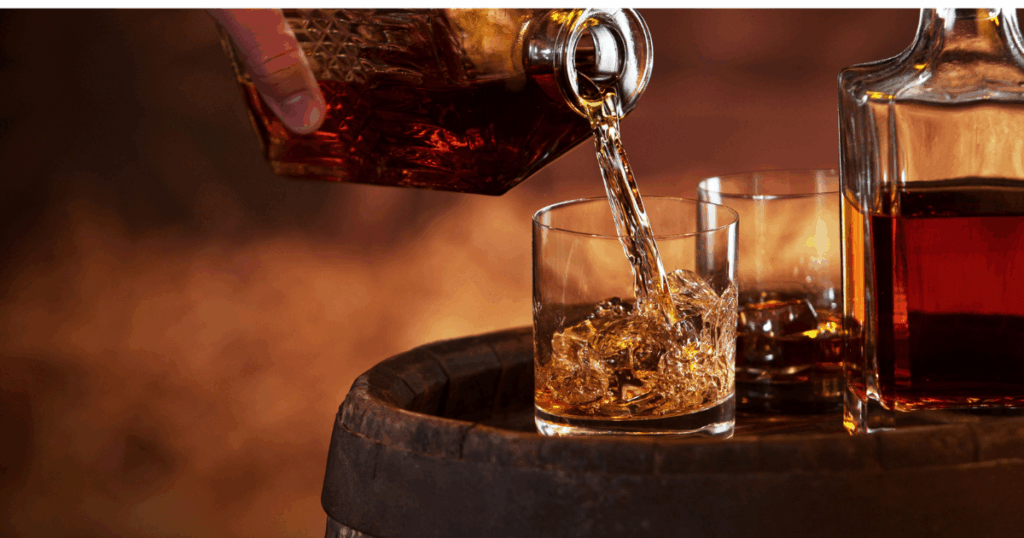Whiskey is a complex and fascinating spirit with a rich history and a wide variety of styles. Whether you’re new to whiskey or looking to expand your knowledge, this comprehensive guide will help you navigate the world of whiskey.
Whiskey, often referred to as the “water of life,” has been enjoyed for centuries. Its intricate flavors and diverse styles make it a favorite among spirits enthusiasts. This guide will introduce you to the basics of whiskey, including its types, tasting techniques, popular cocktails, and tips on storage and serving.
1. What is Whiskey?
Whiskey is a distilled alcoholic beverage made from fermented grain mash. The grains used in whiskey production can include barley, corn, rye, and wheat. The production process involves mashing the grains, fermenting the mash, distilling the liquid, and aging it in wooden casks, typically made of oak. The aging process gives whiskey its distinct flavor, color, and character.
Key Ingredients:
- Barley: Often used in Scotch whisky, barley imparts a rich, malty flavor.
- Corn: The primary grain in bourbon, corn provides sweetness.
- Rye: Adds a spicy, fruity profile to whiskey.
- Wheat: Used in some whiskeys for a softer, smoother taste.
2. Types of Whiskey
Whiskey comes in several styles, each with its own unique characteristics. Understanding these types will help you appreciate the diversity of this beloved spirit.
Scotch Whisky:
- Origin: Scotland
- Types: Single Malt and Blended
- Flavor Profile: Single Malt Scotch is made from malted barley at a single distillery and has a complex flavor profile with notes of smoke, peat, and fruit. Blended Scotch combines malt and grain whiskies, offering a smoother, more approachable taste.
- Aging: Must be aged for at least three years in oak casks.
Bourbon:
- Origin: United States (primarily Kentucky)
- Key Ingredient: At least 51% corn
- Flavor Profile: Bourbon is known for its sweet, caramel, and vanilla flavors, often with notes of oak and spice.
- Aging: Typically aged in new charred oak barrels for at least two years.
Rye Whiskey:
- Origin: United States and Canada
- Key Ingredient: At least 51% rye
- Flavor Profile: Rye whiskey has a spicier, fruitier profile compared to bourbon, with flavors of pepper, baking spices, and citrus.
- Aging: Usually aged in new charred oak barrels.
Irish Whiskey:
- Origin: Ireland
- Flavor Profile: Irish whiskey is typically smoother and lighter due to triple distillation, with flavors of honey, vanilla, and fruit.
- Aging: Must be aged for at least three years in wooden casks.
Tennessee Whiskey:
- Origin: United States (Tennessee)
- Process: Similar to bourbon but undergoes the Lincoln County Process, a charcoal filtering method that mellows the whiskey.
- Flavor Profile: Similar to bourbon but often smoother with a slightly smoky finish.
3. How to Taste Whiskey
Tasting whiskey involves more than just taking a sip. It’s about appreciating the full sensory experience. Here’s how to taste whiskey like a pro:
Look:
- Observe the color of the whiskey, which can range from pale gold to deep amber. The color can give you clues about the whiskey’s age and the type of cask used for aging.
Smell:
- Swirl the whiskey in your glass to release its aromas. Take a deep sniff to identify different scents such as vanilla, caramel, fruit, spices, and oak.
Taste:
- Take a small sip and let it roll over your tongue. Notice the initial flavors and how they develop. Pay attention to the whiskey’s body and texture.
Finish:
- Observe the aftertaste and how long the flavors linger on your palate. A good whiskey will have a long, satisfying finish.
4. Whiskey Cocktails
Whiskey is incredibly versatile and can be enjoyed neat, on the rocks, or in a variety of cocktails. Here are some classic whiskey cocktails:
Old Fashioned:
- Ingredients: Bourbon or rye, sugar, bitters, and a twist of citrus.
- Instructions: Muddle sugar and bitters in a glass, add whiskey and ice, stir, and garnish with an orange twist.
Whiskey Sour:
- Ingredients: Whiskey, lemon juice, and simple syrup.
- Instructions: Shake all ingredients with ice, strain into a glass, and garnish with a cherry.
Manhattan:
- Ingredients: Rye or bourbon, sweet vermouth, and bitters.
- Instructions: Stir all ingredients with ice, strain into a chilled glass, and garnish with a cherry.
5. Storing and Serving Whiskey
Proper storage and serving techniques can enhance your whiskey experience.
Storage:
- Keep whiskey in a cool, dark place to preserve its flavor. Avoid direct sunlight and temperature fluctuations.
Serving:
- Whiskey is often served neat, on the rocks, or with a splash of water to open up the flavors. Use a tulip-shaped glass or a Glencairn glass for the best tasting experience.
Neat:
- Pour whiskey directly into the glass without any ice or water. This method allows you to fully appreciate the whiskey’s flavors and aromas.
On the Rocks:
- Add a few ice cubes to your glass. The ice will chill the whiskey and slightly dilute it as it melts, which can mellow the flavors.
With Water:
- Add a few drops of water to your whiskey. This can help open up the flavors and aromas, making the tasting experience more complex.
Whiskey offers a world of flavors and styles to explore. Whether you prefer it neat, on the rocks, or in a cocktail, there’s a whiskey out there for everyone. Understanding the different types of whiskey and how to taste and enjoy them can enhance your appreciation for this beloved spirit. Visit Pina Wine & Spirits to discover our selection of whiskeys and find your perfect match. Our knowledgeable staff can help you choose the best whiskey for your taste and occasion. Cheers!






